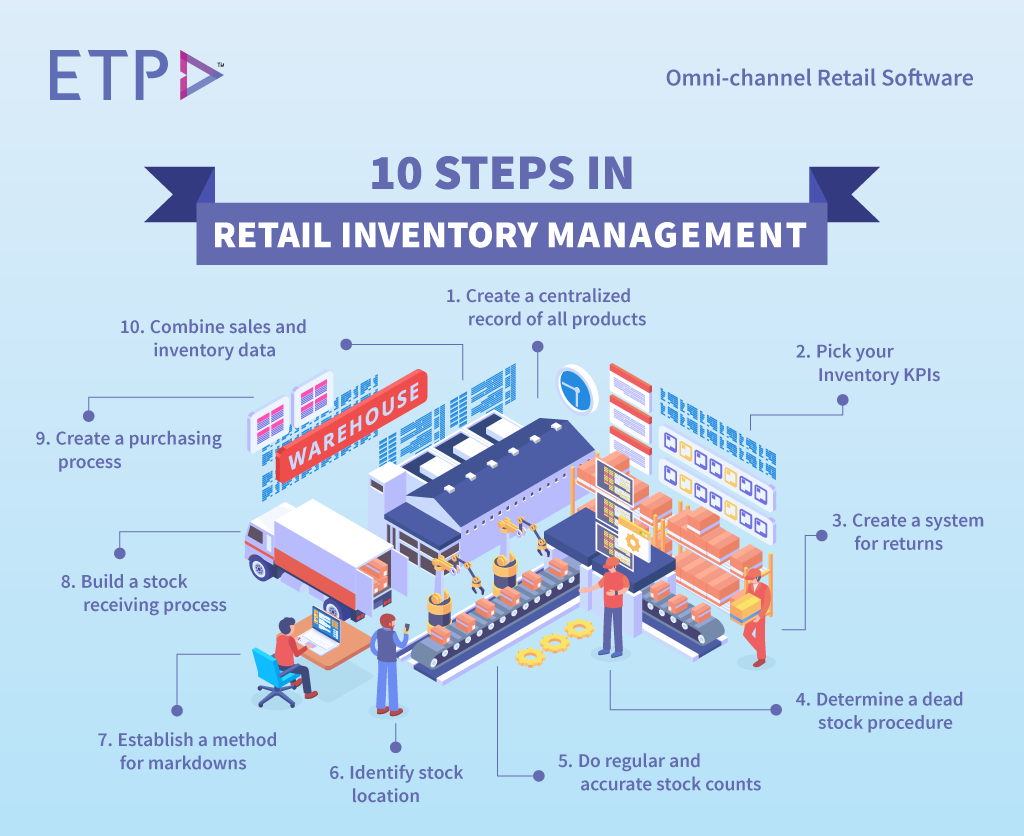
10 Steps in Retail Inventory Management


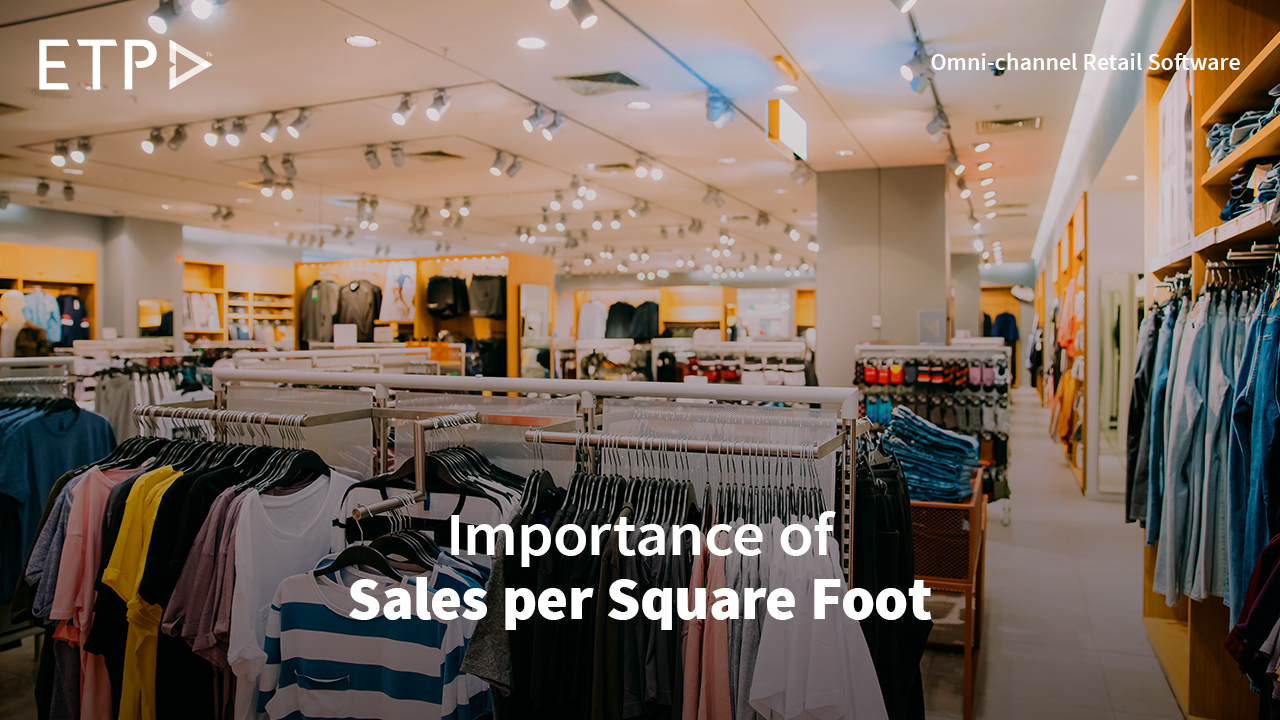
Sales per square foot is a metric commonly used by retail organizations to calculate the amount of revenue generated per square foot of retail space. Sales per square foot can be used to determine the sales efficiency of retail outlets.
Sales per Square foot = Revenue Generated / Total Retail Space
where,
Revenue Generated refers to the amount of sales generated over a defined period
Total Retail Space is the total area of all retail outlets, whether self- or franchise-owned, used by the organization
e.g., an apparel brand generated $45,000,000 in sales revenue through 15 retail outlets last year. The average square footage of each outlet is 100,000. Therefore, the sales per square foot for the last year will be,
Sales per Square Foot = $45,000,000 / (100,000 x 15) = $30 per square foot
Sales per square foot can be used to determine the efficiency of a brand/company’s retail shops. A higher sales per square foot indicates a retail store that demonstrates greater efficiency and performance. For example, a retail company that generates $90/square foot would be deemed much more efficient than a company that generates $30/square foot.
Like many other financial ratios, sales per square foot too should be used in relative terms. The ratio should be compared to the figure for similar competitors and evaluated along with other metrics.
A weak sales per square foot figure could be due to poor utilization of the available retail space.
For example, there may be a retail space that is cluttered with damaged goods or unnecessary equipment. As such, improving store layout by removing the spoiled, inoperative or unnecessary assets from the retail store could help to increase sales per square foot. Creating an engaging environment inside the store that allows your customers easy and adequate access to well-lit trial rooms, installing clear and informative signage, prices and way-finding to reduce retail shopper confusion, simplifying display units, and establishing appropriate atmospherics to suit the industry type and customer preferences within that sector are all key components that can lead to increased sales.
A planogram is a schematic drawing or plan for displaying merchandise so as to maximize sales. It can be a diagram or model that indicates the placement of retail products on shelves, as well as the layout for the entire store. Planograms are important for optimizing the visual merchandising for your brand, organizing and tracking an item’s placement on shelves, analysing retail performance, and identifying the potential reasons for changes in your sales and marketing strategy.
When done right, planograms can do wonders for your brand. Combining your planogram with store level sales data, you can use sales numbers to identify high-selling and low-selling products at each store. You can then either tweak your planogram to have your most popular items in your brand’s most valuable shelf spaces or adjust your shelf positioning to boost the performance of products that may be lagging, and start seeing new levels of retail sales.
Every buyer today is a digital customer with ever-increasing expectations for quality and a hassle-free and unified shopping experience across their digital and in-store activities. An important aspect of this experience is the ready availability of the right products and the right variants of colour, size, model, or style/pattern. Stocking up on what sells is a sure-fire way of increasing sales. Additionally, being able to present your entire virtual and warehouse inventory in a single screen to your customers avoids lost sales due to stock-out situation at a store. Contrariwise, carrying too much stock of products that are unappealing to customers could lead to poor sales per square foot
Employees are drivers of sales in a retail store – store employees directly impact customer satisfaction and sales. For example, employees with a strong knowledge of company products are in a better position to cross-sell and up-sell the company’s products. As such, providing employees with adequate training (product knowledge, up-selling and cross-selling tactics, etc.) goes a long way in improving sales per square foot.
Retail is an industry that never stops moving and must adjust to evolving customer expectations in real-time. Growth projections estimate that by 2023, retail sales will exceed $29.7 trillion worldwide. Modern retail technology is changing everything about shopper expectations and retail operations. The customer journey is becoming increasingly varied and personalized – customization that shoppers have come to expect. Implementing the right technology solutions enables you to maximise the retail experience for your customers by offering them a range of benefits such as personalized promotions, endless aisle functionality, freedom from sluggish checkout lines, secure and contactless payment transactions, click and collect or doorstep delivery options, instant earn-and-burn of loyalty points, being able to share their feedback across channels, and many more.
With the advent of e-Commerce, even though consumers can now order products of their choice from their phones and have them delivered to their home/preferred location easily, the importance of sales per square foot analysis in the overall business performance optimization cannot be denied or ignored. It can not only help improve store productivity, but also turn your customers into brand loyalists leading to higher sales revenues.
For companies that utilize online as well as physical stores, it is important to gauge the efficiency of the company correctly as the sum of sales per square foot area of their physical retail space and their online conversion rate.
ETP’s omni-channel retail software is here to simplify and accelerate your retail processes. It has been successfully enabled retailers across various verticals to drive traffic to stores, increase sales per square foot and reduce operational costs in the long term, thereby creating an excellent value for retailers and end customers.
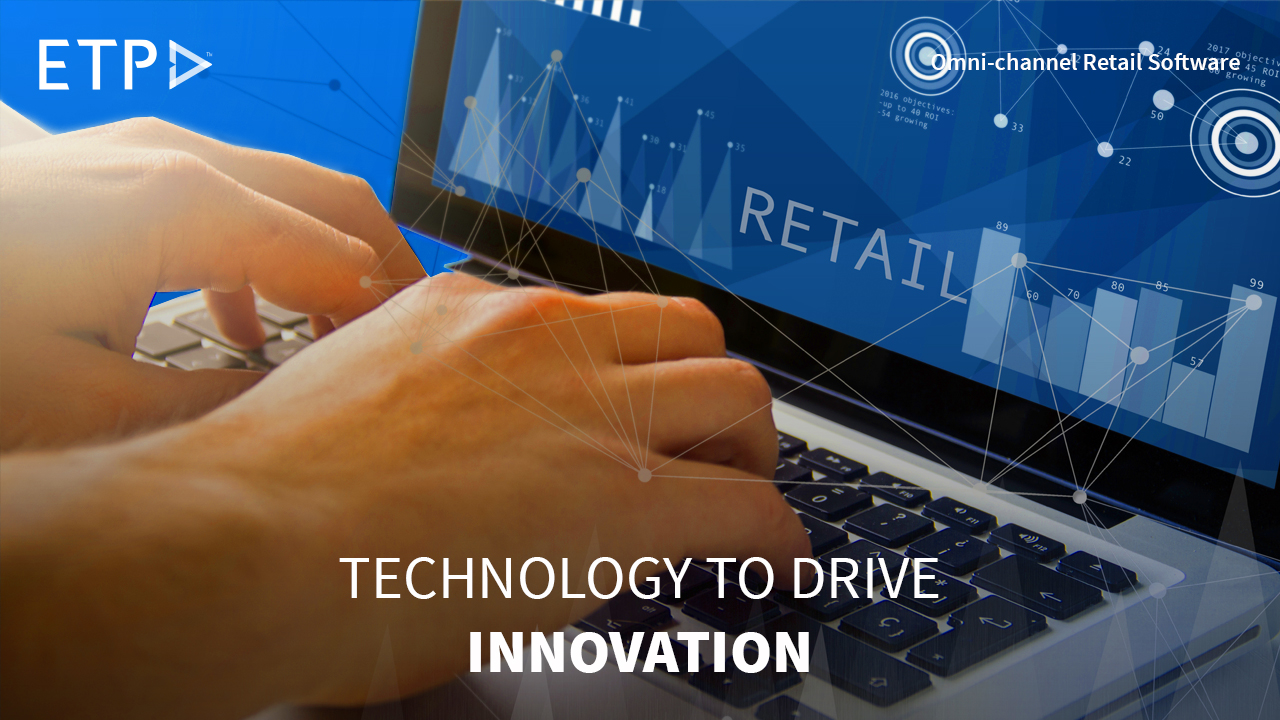
Innovation in retail has long been driven by new technologies and the desire to see what they can do. From video rental shops to Amazon, retailers have fallen over themselves to adopt tech that gives them an edge over the competition—and a bigger piece of the pie. Today, brick-and-mortar stores face much stiffer competition than their online rivals. After all, how can you compete with the convenience of shopping from the comfort of your own home? You could argue that you can’t. But I’m here to tell you there are still plenty of ways for physical retailers to use tech to innovate and get ahead in this brave new world. Here’s a look at just some of them:
Remember the days when customers visiting a store were greeted with a salesperson following them from aisle to aisle, making product recommendations and steering them towards the cash counter? It’s not that long ago that such practices were commonplace in retail. But today’s customers are more demanding than ever before—they want to be able to shop whenever and wherever they want, without being followed by a salesperson or being pushed into buying more than they need.
As shoppers now seek a more convenient method of shopping, it is imperative for brick-and-mortar stores to reinvent themselves by offering an omni-channel experience and creating a seamless shopping experience for their customers. While the use of technology can serve as an effective tool in achieving these goals, retail companies need to take the initiative to stay relevant and useful to customers.
The importance of leveraging technology cannot be overstated when it comes to transforming information into actionable insights in order to personalize interactions with shoppers. By doing so, organizations can create a superior customer experience that sets them apart from competitors who lack these capabilities.
The first step toward delivering this enhanced shopping experience is through digital technology that, among other things, enables data gathering at multiple touch points. This gives retailers access to a goldmine of customer information that helps businesses to remain relevant and useful to their customers.
But how do you use this data? How do you know what kind of information you should be collecting? How much should be collected? And how can it all be used effectively in order to improve the overall customer experience?
Data is truly a gift from heaven for retail companies—and not just because they can use it as part of their analytics efforts; data collection also provides important insights into consumer behaviour and preferences. With this knowledge in hand, companies are able to create personalized experiences for each individual shopper based on their shopping history and preferences rather than relying simply on demographic information such as gender or age range alone (which may not always accurately represent them). It also allows retailers greater insights into where there might be demand for new products/services or locations within stores, where consumers prefer spending time during different parts of their day (e.g., morning vs afternoon shifts) and so on.
The next step involves leveraging technology tools available today to transform that information into actionable insights. These insights can be used to personalize interactions with shoppers based on their unique browsing and buying patterns and to proactively address their changing needs throughout their journey, from purchase to return.
This is the heart of a customer-centric approach that can make all the difference in your store’s ability to get things right for your customers. With it, you will:
Additionally, retailers should use artificial intelligence and machine learning to improve customer service. For example, a retailer could install cameras at the entrance of the stores to monitor the flow of customers during peak shopping hours. This data can then be used to determine where additional staffing may be needed or identify bottlenecks along the customer journey so that employees can address them immediately.
Data analysis can also be used by retailers who want to deliver superior customer service as well as track consumer trends across the supply chain, helping them optimize inventory management practices and streamline production schedules.
Retailers have access to a wealth of consumer data thanks in part to social media. By leveraging this information, companies will be better equipped to serve customers’ needs by providing the products and personalised promotions they want when they want them—even before they know what those desires are.
The ability for companies to quickly identify consumer trends allows them to not only plan, but also to identify cross-selling opportunities.
Digital transformation is no longer an option for retailers, but a business imperative. If you’re not leveraging technology to drive innovation, the process of change will still happen — your competitors and customers will be the ones who lead it.
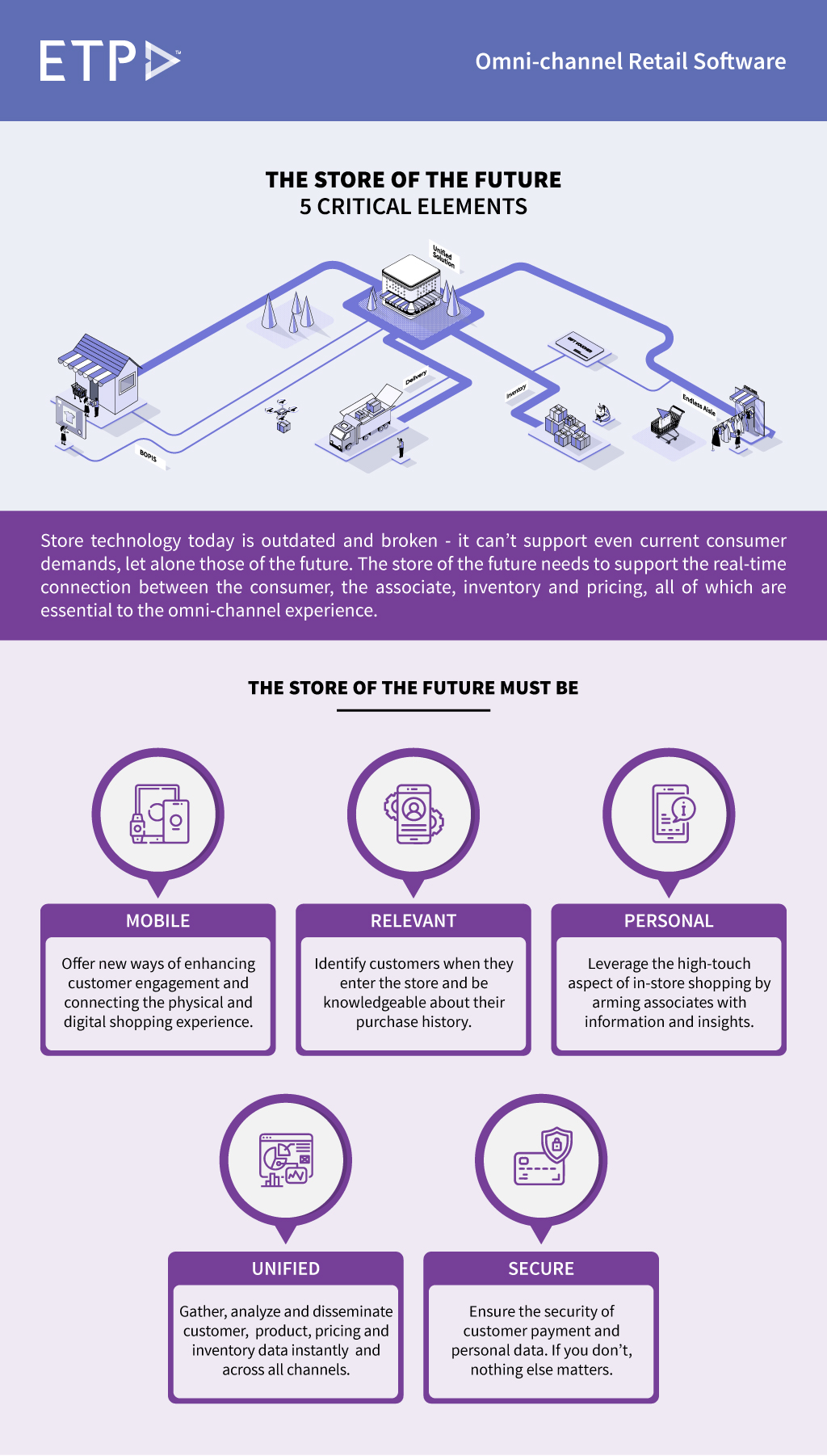
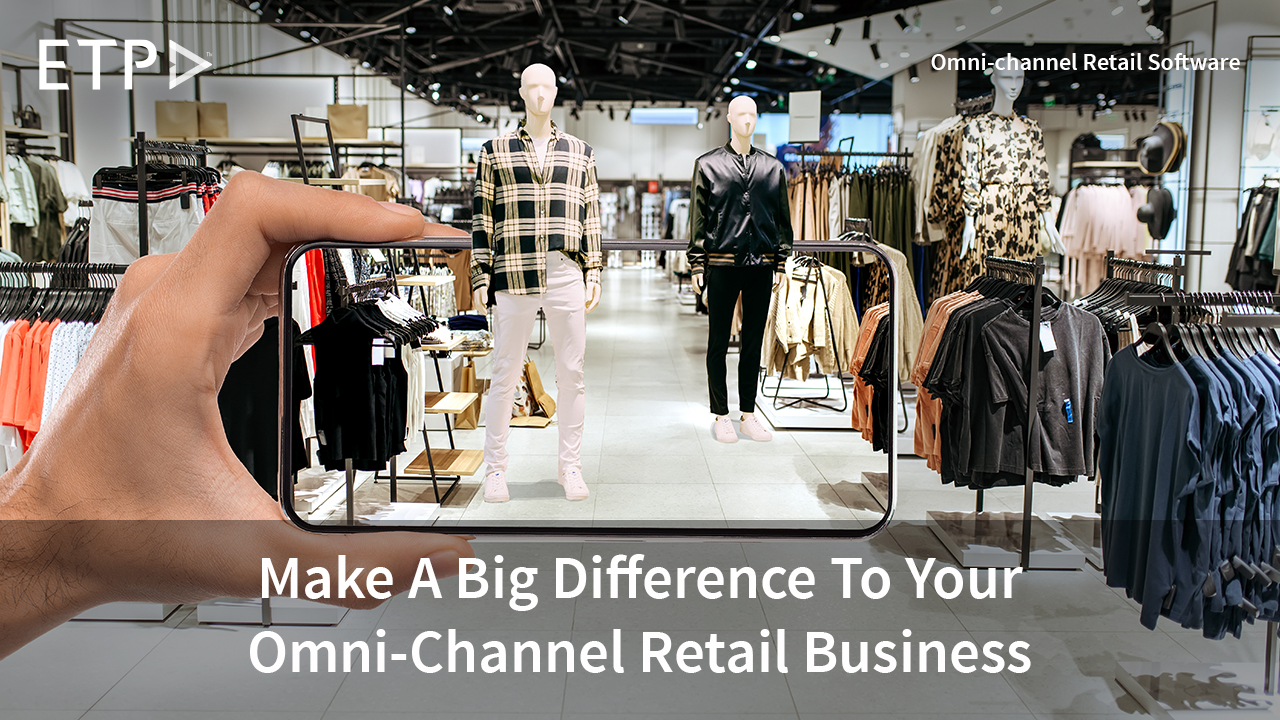
Omni-Channel retail businesses offer a multichannel approach to sales by providing a seamless customer experience across all channels. Whether the customer is shopping online via a mobile device, laptop, tablet, or a brick or mortar store. The goal is to offer a fantastic shopping experience that makes them come back for more.
This article will help you incorporate five significant changes you need to make that will make a big difference to your omnichannel retail business.
An omni-channel retail software has the power to grow your omni-channel retail business quickly and effectively. The software aims at offering a unified and optimized customer experience by a seamless integration of all customer touchpoints. It smartly integrates back-end retail business operations with supply and demand channels, ensuring that your retail business always offers its customers the products they are looking for. Further, omni-channel retail software improves the overall customer experience and offers multiple purchase channels like mobile, web, and in-store. Customers can conveniently carry out purchases via different channels and select a convenient mode of transaction (cash, card, etc.).
All retailers know that the customer makes the most significant difference to their omni-channel retail business. Customers are the heart and soul of retail businesses, and prioritizing their needs is a must.
Retail businesses must focus on offering a fantastic customer experience to their customers irrespective of their purchase channel. Creating a great customer experience involves knowing your customer’s purchase behavior and purchase cycle. It also involves ensuring that the products they like are always in stock.
Retailers must focus on increasing customer loyalty via customer loyalty programs, special discounts, sales, and coupons. This makes the customer feel valued and unique. Once you tap into your customer’s purchasing needs, you tap into maximized revenue for your retail business!
The omni-channel retail software assists retailers in discovering and prioritizing their customer’s needs.
Customer data is valuable information. It consists of important customer information such as contact details (name, gender, age group), past purchase history, purchase channel, and more. Accessing this information and using it strategically makes a big difference to your omni-channel retail business.
How’s that? Successful omni-channel retailers strategically capture this data and turn it into action.
Intelligent retailers systematically align messages, objectives, designs, and information across platforms to ensure a unified retail working channel. This results in redesigning the shopping journey and turning it into a seamless and all-encompassing experience.
If you are confused about where to begin, your first step can be investing in robust omni-channel retail solutions such as the one offered by ETP.
The software is packed with powerful features that help retailers use their customer data strategically.
The worst thing an omni-channel retail business can do is offer an inconsistent and disconnected brand experience across different channels.
Retailers must remember that consistency is the key to creating a successful brand. It involves creating a solid brand image and a quality brand experience in-store via a mobile app, brand website, or social media channels; you must ensure brand consistency.
If customers are the soul, then an updated inventory is the heart of your retail business. Every retailer will agree to this. Retailers must always stock their retail business with the products that customers love.
It is why retailers must invest in comprehensive and robust stock management solutions.
Intelligent inventory management solutions help retailers in inter-stock transfers, warehouse to store stock transfer, store to warehouse transfers, direct to store deliveries, etc. Retailers can perform local purchases; retailers can stock up customers’ favourite products. Inventory management solutions also show product availability in a real-time format, allowing customers and retailers to discover which products are in stock and out of stock. Any changes in the inventory instantly reflect on all touchpoints.
ETP’s omni-channel retail software perfectly integrates with ETP’s omni-channel inventory management solutions, indeed growing your omni-channel retail business.
ETP’s omni-channel retail software is here to simplify and accelerate your retail businesses.
It promises to create extraordinary customer experiences by personalizing physical and digital retail channels, thereby creating an excellent value for retailers and end customers.
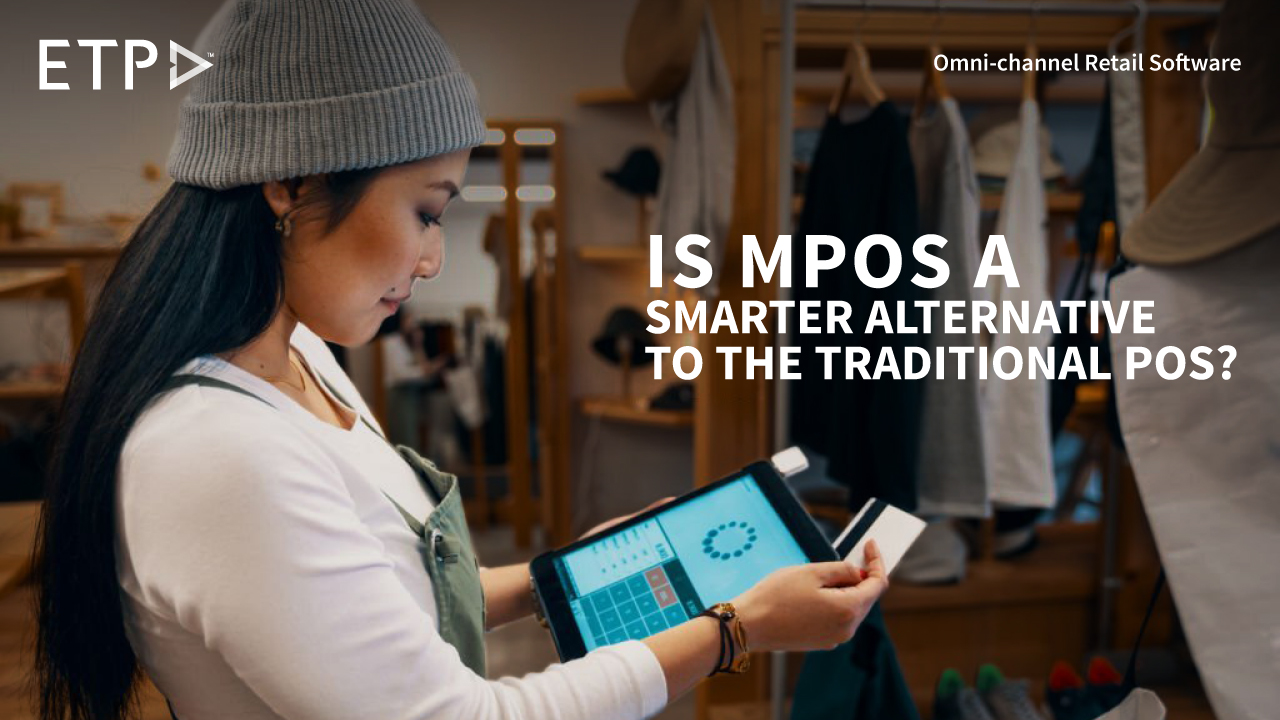
During the past two decades, most retailers in Asia Pacific and India have already replaced the typical manual billing systems with robust and dynamic POS software solutions that support multiple payment gateways, easy checkouts, and improve the overall customer shopping experience. These traditional POS systems play a critical role for retail businesses as they offer several business-specific features like inventory management, sales reports, and integration with backend retail operations.
However, modern customers nowadays expect to make their retail purchases quickly and without any hassles. So, retailers cannot solely depend on POS software and must adopt Mobile POS solutions as well into their businesses.
Both mPOS and POS software play a crucial role in facilitating a retail businesses’ productivity and sales. Retailers looking to scale up their in-store shopping experience must rely on both these solutions for a higher profit-generating business outcome. They need to include mPOS systems into their retail operations as these prove to be a more innovative and modern alternative to POS solutions.
This article aims to help you understand why Mobile POS software or mPOS is a more intelligent alternative to POS software.
The most important aspect of this mobility revolution is centered on customer personalization, portability, and easy access to a more connected, mobile internet. These factors play the most crucial role in mobile point of sale for retail operations where the retailers want to gain customer sales and satisfaction over their products, especially in the luxury and lifestyle environment.
With ETP being able to deliver a complete Mobile POS solutions program, that seamlessly has complete billing, inventory look up, and retail mobility solutions over iOs or android based smartphone devices, retailers can now easily manage their customers’ buying history, allow customers to add loyalty points, look up stock, generate invoices based on their purchase or put the bills on hold, collect payments securely, and more importantly reduce queues, thereby maintaining safe distancing between customers at the stores.
ETP’s Mobile POS solution, ETP Mobile Store makes your business transactions simpler and convenient! With intelligent features like easy deployment, endless aisle item search, product lookup, and quick and convenient billing, this mPOS system eases your daily transactions. It promotes customer satisfaction, thereby increasing your sales and profits.
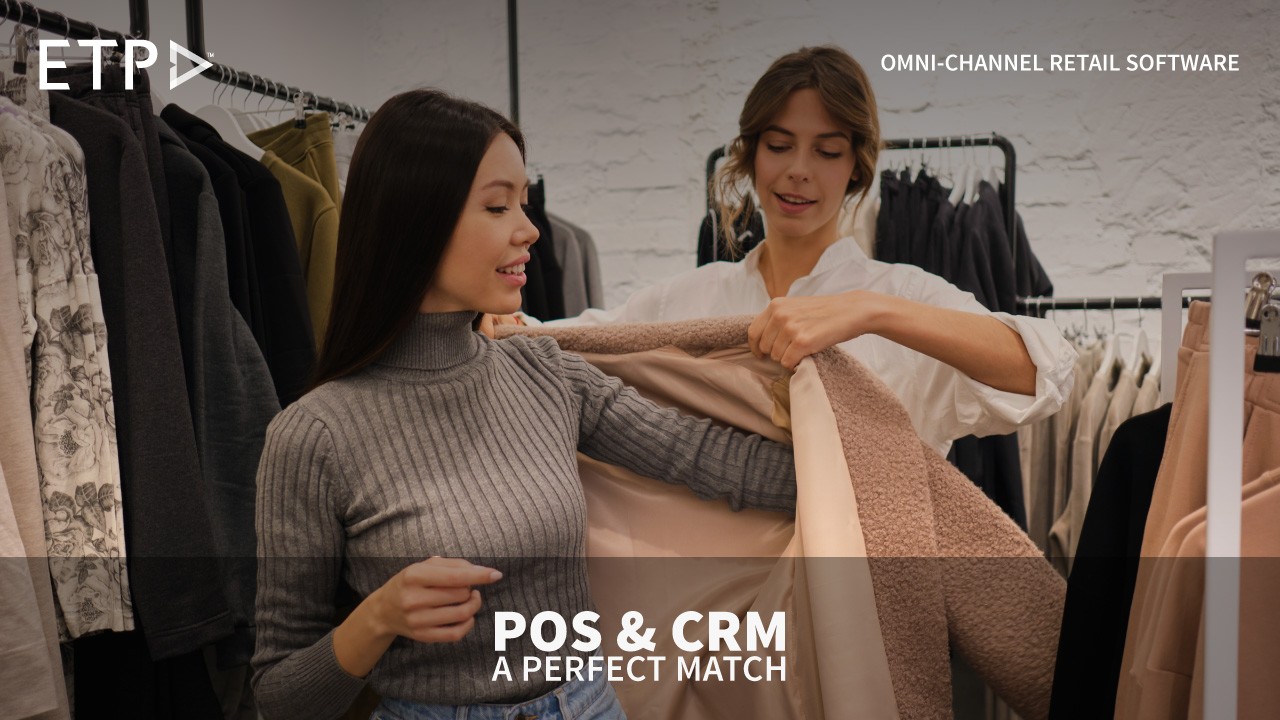
As a retailer, you are most likely already using a retail POS system a retail CRM system. But are you aware of the advantages of having these two systems integrated and working together? If you are, you are already well on your way toward achieving retail success. If you are not, then these programs are probably working against you.
There are many benefits to having an integrated POS and CRM solution including faster transaction time, detailed customer history, and improved customer experience, to name a few. In this article, we will focus specifically on the benefits of capturing detailed customer history, and how the collected data can be used effectively. When your retail POS and CRM are integrated with each other, all your retail sales data is immediately and automatically captured in the CRM – every sale, service request, and customer complaint is logged, giving you a detailed customer profile.
Complete customer profiles provide information that can be extrapolated and applied in a variety of ways.
First, imagine a customer that has come into your retail store — let’s say you specialize in wireless products. The customer browses around for a minute or two and settles on purchasing the latest Bluetooth speaker. When they get up to the till (retail POS solution) for billing, the sales representative scans the item and in doing so, the customer profile is brought forward from the retail CRM software and the sale can be attached to their account. At this point in the integrated system, the sales associate will be able to view this customer’s entire purchase history based on recency-frequency-monetary value and will have access to valuable upgrade information, using which he/she can cross-sell or upsell with additional correlated products, or share deals that may apply to this customer.
Secondly, the customer data you collected can be used to segment your customers as per their purchase history, upgrade eligibility, and even as far as demographic information that can help you identify your purchase audience. The key benefit here is, you can now begin hyper-targeting your customer base and hone marketing efforts based on these unique profiles that bring customers back into stores.
Finally, integrated data collection is a game-changer with the ability to take the customer data and include it in your communication to customers; this is referred to as personalization. The ability to use personalization in your marketing and customer relationship efforts goes a long way, and according to a report by Forrester, the biggest challenges with personalization are gaining insight quickly enough (40%), having enough data (39%), and deciphering what is inaccurate data (38%). With an integrated POS and CRM, these key issues with executing personalization are largely alleviated, connecting the sales and customer data and by displaying the information at the POS.
Think back to that customer who came in and bought the Bluetooth speaker. You have already captured their demographic information and because your CRM and POS are integrated, you now have their sales history including details of the product they bought, the store they bought it in, and the sales rep that sold it to them. With this information, a powerful, personalized email can be created and sent to them to make sure they are enjoying their purchase, generating customer loyalty and mostly repeat business.
So I will ask again, is your POS and CRM integrated with each other and working together?
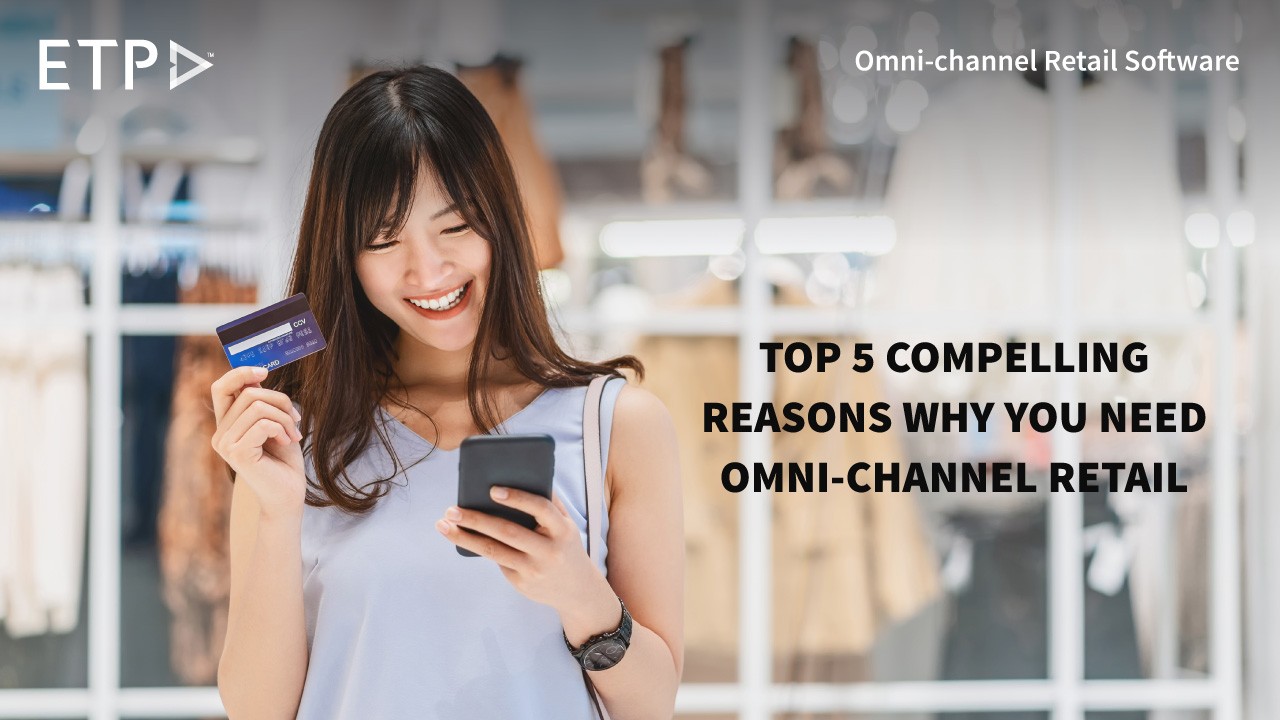
The concept of omnichannel retailing has now taken over a majority of the retail industry, with retailers focussing on providing a consistent, coordinated omnichannel customer experience across all customer channels using consistent and universal data.
So, what is omnichannel retail?
Omnichannel retail involves a dramatic shift from the multichannel retail approach. This retail strategy refers to a business model wherein all existing channels are integrated to offer customers a seamless and omnichannel shopping experience. The strategy is empowered by centralised data management, which blurs the lines between online and physical channels.
Customers can seamlessly use different channels in their shopping processes and are given a unique opportunity to create their preferable shopping routines. The omnichannel retail approach is adopted simultaneously in inventory management, sales channel, and marketing strategy.
This article aims to help retailers understand the need of investing in omnichannel retail:
Omnichannel retailing results in an omnichannel customer experience that seamlessly integrates online and offline channels. A retailer’s ultimate goal should not be to generate sales in a specific channel but to allow purchases to occur naturally and conveniently in the channel chosen by their customers.
By integrating online and offline channels, customers can shop from anywhere and experience an optimized retail experience. Be it shopping in brick and mortar stores or via using apps or company websites, customers can interact on all channels, efficiently manage their loyalty points and rewards, and invest in quick transactions. This type of interaction at all levels helps in improving customer relationships and pushes them to interact on a deeper level with retail brands.
With an omnichannel retailing set-up, shoppers can shop from whichever channel they like, physical stores or online channels. With inventory management integration in the retail strategy, retailers receive stock visibility across all channels and gain accessibility into the customer’s favorite channel. This retail strategy also integrates multiple sales channels, and shoppers can pick the most convenient one, thereby leading to an increase in sales.
Shoppers aim to buy products in a way that is most convenient to them. An omnichannel retail strategy is the best way of offering your customers various sales channels and letting them pick one that best suits them. Further, omnichannel retail incorporates multiple payment gateways that ease transaction processes. This leads to optimized checkout rates and quick and secure checkouts, resulting in increased customer retention.
With an intelligent omnichannel retail solution, retailers can store all customer data centrally located on cloud databases. The valuable data may include essential customer information like contact details, purchase histories, etc. Retailers can take advantage of this data for creating personalized shopping experiences for customers. They can monitor customers across all channels, understand them better, know their preferences, and create targeted marketing campaigns and customized promotions for every client that makes them feel special.
The omnichannel retail experience offers a 360-degree view of all the customer purchases that helps to serve them better in the future. The integration of loyalty management programs further increases productivity.
Customers can pick, review information, offer feedback, purchase, promote, and like products from anywhere that increasing overall productivity and efficiency.
ETP’s omnichannel retail software offers an amazing omnichannel retailing experience
An intelligent omnichannel retail software integrates all crucial retail operations such as the point-of-sale, inventory management, customer relationship management, etc. by providing a single point solution for all retail processes irrespective of the channel. It perfectly integrates the backend operations with the demand and supply channels, offering physical and digital retail personalization to the customers which improves their overall experience and visibility of the brand.
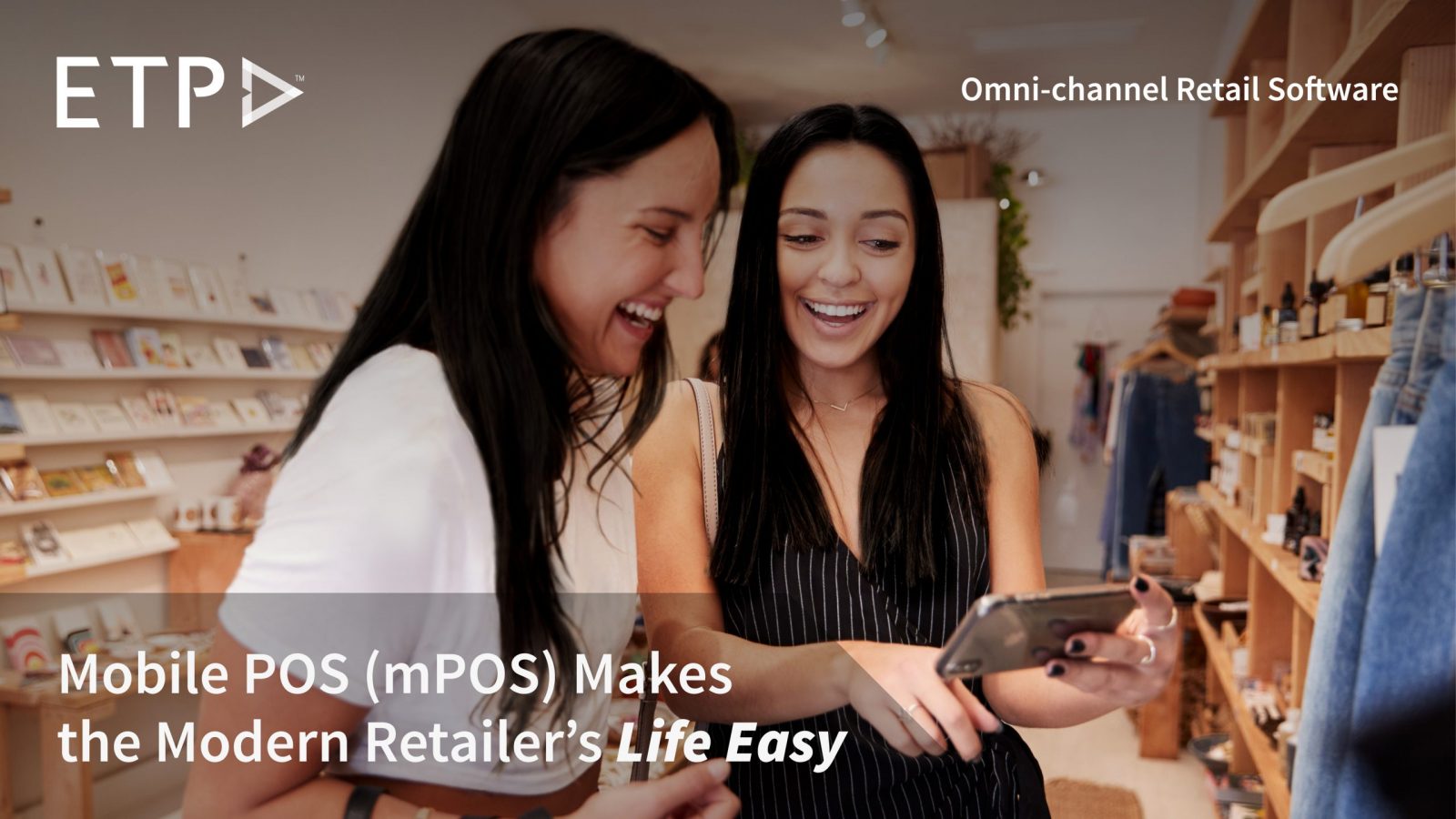
The grueling responsibility of running a retail business efficiently can be made manageable by using a robust and dynamic Mobile POS (MPOS) system. Mobile POS solutions allow retailers and merchants to access POS functionalities on iOS or Android devices. These solutions turn any smartphone, tablet, or wireless device into a powerful, modern-day system that performs the functions of a cash register or electronic POS terminal wirelessly. The correct MPOS system will also help you keep track of sales and customer information, boost employee productivity, and offer a seamless customer experience and service. A capable mPOS system can help retailers in taking their brand or company to the next level in the near future.
A Mobile POS system, also known as a Mobility Retail Solution, works on a tablet or handheld device that is either iOS or Android enabled. It is cloud-based, which means that all the data captured by the device is automatically backed up and saved online. Its advantages in terms of customer service (queue busting, ensuring safe distancing in the stores) and the speed with which it records data and monitors transactions can just not be ignored any longer. Most significantly, it aids in comprehending complex data, allowing business owners to solve issues and tailor their strategies for long-term success.
This blog will help you understand how mobile POS systems can make a retailer’s life easier.
Inventory management
Terrible inventory management is without a doubt bad for retail businesses. After all, it is your stock that attracts customers to your store. With inventory issues across stores and across channels such as stock out and pilferage becoming all too typical these days, it’s clear that retailers need to improve their inventory tracking and management system.
During peak sales periods such as the festive season especially, it is common to see empty shelves and frustrated shoppers. Store staff is unable to replenish the stock on the shelves in time and that leads to unfulfilled sales which leaves the shoppers unsatisfied as they feel they made a wasted trip down to the store. With the endless aisle feature, stores are no longer limited by their shelf space. With the Endless Aisle Item Search functionality, you can easily list your entire inventory across stores and at warehouses online in a single screen and empower your store staff to offer suggestions to in-store shoppers for goods that are not on the shelves and allow them to choose from the entire inventory available.
You can thus monitor your transactions against your existing stocks without breaking a sweat using an MPOS system. This real-time accounting provides you with a realistic picture of the status of your inventory. And, because your MPOS can manage and sort goods by categories, tags, and serial numbers, you can track supply fluctuations and determine which ones need to be replaced.
Provide great customer experience
When it comes to providing an outstanding customer experience, cloud-based mobile point of sale gives your associates more time with their customers. It makes them happy by removing the difficulties they experience when dealing with technology that doesn’t work or isn’t doing its job effectively.
Your employees will give superior service, and your customers will be able to check out on the spot using a mobile point of sale. Your store staff can scan the merchandise anywhere in-store, hold the bill if needed, offer line discounts during the checkout process, and collect the payment to enable queue busting at the store. This improves customer satisfaction, which leads to increased and/or repeat sales. You’ll be able to provide that desired shopping experience by providing your efficient employees with great tools.
Better Analytics Leads to Better Decisions
This is where some of MPOS’s most outstanding features come into play. MPOS includes a robust reporting system that can provide you with real-time or near-real-time sales data. You may usually filter by date, product ID, customer, and other factors in addition to just totaling transactions. These tools allow you to delve deep into your data to determine what is selling and what isn’t, and how to adjust your strategy accordingly.
Digital Receipts
Your customers now expect digital receipts in addition to contactless payments. They are seen as safer, more reliable, and more convenient once again. Offering digital receipts is a highly successful technique to acquire your consumers’ email addresses, adding to your marketing database.
Following are 4 main reasons to upgrade to a mobile POS (mPOS) solution:
A fast and secure mPOS solution such as the ETP Mobile Store solution allows you to handle all of the above and more from a single screen. Furthermore, when running your business from the cloud, it’s simple to adapt services and extend capabilities as your company expands and your customers’ needs change. Mobile point-of-sale systems provide a well-organized, quick, and anywhere checkout, allowing store staff to handle clients swiftly. A robust Retail Mobile POS solution also enables a variety of contactless payment choices.
ETP’s Mobile POS solution seamlessly integrates and offers user-friendly experiences. It can also help you scale your business, be more responsive to customer requests, and forecast your revenue. Its unique value proposition is its ability to continuously offer enterprise-grade Omni-channel retail solutions to its clients while also forging decade-long strategic collaborations and partnerships.

Imagine you are buying your favourite luxury car that offers you a choice between manual, automatic, and driverless options; passive, active, interconnected front and rear suspensions; disc, drum, or anti-lock braking systems; plush amenities such as higher-quality interiors, high-viability headlights, auto-dimming mirrors, safety features; and, comes in petrol, electric and hybrid variants. But imagine if the car dealer said he could offer you a choice in only one or the other category. What kind of a horrid car buying experience would that be! Versus that, if another car dealership across the town offers you a choice in each of the categories along with a few extra features such as a great infotainment system or a voice-activated security system, wouldn’t that be a truly amazing experience? And now, imagine if the ‘you’ in the example above is actually your end customer, the ‘car dealership’ is your retail brand and the ‘luxury car’ along with its various features is the retail technology suite your brand is relying upon to offer a truly amazing unified shopping experience that makes your customers keep coming back for more.
If you’re in retail or even e-commerce, then you already know that omnichannel retail has changed the game in terms of how businesses reach and interact with their customers. If you want to stay competitive, it’s no longer enough to have a multichannel presence where the different channels function in silos and, it never will be again. What you need is unified commerce solutions, which enable your business to deliver consistent experiences across all channels — in-store, mobile, and digital — to make sure that your brand is staying ahead of the competition.
If you’re new to unified commerce, you may be wondering what exactly it is. The term can be defined as one platform serving several use cases. It encompasses many different tools, whether online or in-store, that customers utilize at different points throughout their journeys. Customers make purchases across platforms like mobile apps, websites, retail locations, social media pages, and connected devices. With the proper utilization of all these channels, interactions between brands and consumers can take place in real-time. For example, if an e-commerce company has an app that offers customers an easy way to shop for products anytime or anywhere they want (including on the go), it’s offering a very specific type of unified commerce experience.
The rapid growth of omnichannel has left retailers with one distinct problem – how to provide a seamless customer experience across all channels when managing multiple systems can be quite complex. The rapid proliferation of digital touchpoints has created complexities that leave retailers struggling to manage multiple systems, networks, and data silos in order to create a customer-centric experience. However, there is hope on the horizon with unified commerce platforms that bring order out of chaos by aggregating product data into a single source of truth. By integrating POS, WMS, ERP, CRM/CMO solutions into a single platform for managing merchandising content, brands can deliver more personalized shopping experiences while also unlocking critical insights about customers throughout their journey.
If you’re a retailer, then chances are your website is already unified. In fact, you probably already have a mobile shopping app for your brands. But what about in-store shopping? That’s where you might be falling behind. According to Gartner, over 30% of retail sales still take place in physical stores, but in 2025 more than 65% of sales will occur online. If that prediction holds true, then it doesn’t bode well for retailers that aren’t prioritizing unified commerce solutions at their brick-and-mortar locations or on their websites.
A unified commerce platform is a single, all-encompassing digital storefront that gives customers complete access to your brand, products, customer service channels, mobile apps, social media accounts, websites, etc. The goal of unified commerce is to encourage your customers to interact with your brand through multiple channels while simultaneously making it easy for them to find the information/product they are looking for. To do so successfully requires cross-channel product listings that are consistently accurate. Also critical is an omnichannel experience where any interaction with your brand automatically updates in real-time across every channel. Even more importantly, it allows you to meet each customer on his or her own terms by offering customized interactions tailored directly to their preferences.
Most retailers are already experiencing growth in sales, which means their infrastructure should be ready to support increased growth. For example, if a company has only 200 customers today but expects 1,000 new customers within 12 months, then unified commerce is critical. With integrated systems across all channels of communication, businesses can better understand who their customers are. This will allow them to deliver an experience that’s personalized for each individual customer. Because of omnichannel capabilities combined with retailer-specific features designed to grow your business, unified commerce helps you grow your bottom line while staying ahead of industry changes.
The first advantage of unified commerce is that it allows businesses to offer customer-centric shopping experiences. Customers want a seamless shopping experience, which means it should be easy for them to browse products on their smartphones and buy those products quickly and efficiently through an e-commerce site or a mobile app. Giving your customers quick access to your inventory as well as options like click-and-collect delivery services increases their chances of making a purchase with you. Giving them multiple ways to complete purchases, such as email receipts and pick-up codes for shoppers who order online but don’t have home delivery service available in their area, also makes purchasing easier for them — and makes them more likely to shop with you again in the future.
When we at ETP were building our product roadmap in 2015-2016, we already had a good idea that omnichannel retail solutions would be one of our most in-demand products over the next six years. However, once we had firmly established ourselves as an Omni-channel Retail Solutions provider for luxury and lifestyle retailers across APAC, India, and the Middle East in 2018-2019, we saw that unified commerce was quickly becoming a trending topic in the immediate future as well. At that point, it was clear that unified commerce was going to be one of our key points of focus for our 2025 strategy. As such, we decided to develop specialized products that can benefit that various types of retailers. We have also created a dedicated page on its core components and main advantages to help you better understand unified commerce and omnichannel retail solutions.
